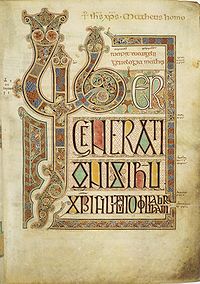Lindisfarne Gospels
- Lindisfarne Gospels
-
Évangiles de Lindisfarne
Les Évangiles de Lindisfarne (Lindisfarne Gospels en anglais) sont un manuscrit enluminé rédigé en latin. Ils comprennent les quatre Évangiles du Nouveau Testament et ont été réalisés à Lindisfarne, dans le royaume de Northumbrie, entre la fin du VIIe et le début du VIIIe siècle. Le manuscrit de Lindisfarne est généralement considéré comme le plus bel exemple de l’art religieux si particulier de ce royaume, qui combine des influences celtiques et anglo-saxonnes et en fait la symbiose dans un « art irlando-saxon ».
Les Évangiles de Lindisfarne sont réputés être l’œuvre d’un moine nommé Eadfrith, qui devint évêque de Lindisfarne en 698 et mourut en 721. Les chercheurs contemporains situent la date de création vers l’an 715, et l’on s’accorde à penser que le manuscrit fut réalisé en l’honneur de saint Cuthbert. Les Évangiles sont richement illustrés dans un style typiquement insulaire. Ils étaient dotés à l’origine d’une reliure soignée faite de cuir, de pierres précieuses et de métaux, réalisée par un anachorète du nom de Billfrith au VIIIe siècle. La couverture fut néanmoins perdue au cours des raids vikings, et il fut procédé à son remplacement en 1852.
Aldred, prévôt de Chester-le-Street, procéda au Xe siècle à une traduction des Évangiles de Lindisfarne en vieil anglais, en insérant une transcription mot pour mot entre les lignes du texte latin : il s’agit de l’une des premières traductions de textes bibliques en anglais.
Au XVIIe siècle, les Évangiles entrèrent dans les possessions de Sir Robert Cotton. La bibliothèque de ce dernier échut au British Museum au XVIIIe siècle, et de là parvint à la British Library de Londres. Il existe au nord-est de l’Angleterre un mouvement visant à ramener les Évangiles de Lindisfarne à leur région d’origine.
Voir aussi
Articles connexes
Liens externes
Catégories : Manuscrit enluminé | Document conservé à la British Library
Wikimedia Foundation.
2010.
Contenu soumis à la licence CC-BY-SA. Source : Article Lindisfarne Gospels de Wikipédia en français (auteurs)
Regardez d'autres dictionnaires:
Lindisfarne Gospels — The Lindisfarne Gospels is an illuminated Latin manuscript of the gospels of Matthew, Mark, Luke and John. The manuscript was produced on Lindisfarne in Northumbria in the late 7th century or early 8th century, and is generally regarded as the… … Wikipedia
Lindisfarne Gospels — a book containing the four Christian Gospels, produced on the island of Lindisfarne around AD 700. It is written by hand, with many beautiful pictures and decorations, and contains early examples of the northern version of Old English. It is now… … Universalium
Lindisfarne Gospels — Lin|dis|farne Gos|pels, the an ↑illuminated (=with the pages decorated with gold paint and other bright colours) copy of the four Christian ↑Gospels, produced at the end of the 7th century on the island of Lindisfarne and now kept in the ↑British … Dictionary of contemporary English
(the) Lindisfarne Gospels — the Lindisfarne Gospels [the Lindisfarne Gospels] a book containing the four Christian Gospels, produced on the island of ↑Lindisfarne around AD 700. It is written by hand, with many beautiful pictures and decorations, and contains early examples … Useful english dictionary
Lindisfarne (disambiguation) — Lindisfarne has several meanings:As place names:*Lindisfarne, island linked to Northumberland, England *Lindisfarne, Tasmania, suburb of Hobart, Tasmania, AustraliaOther uses:*Lindisfarne Gospels, created on Lindisfarne, Northumberland… … Wikipedia
Lindisfarne — For other uses, see Lindisfarne (disambiguation). Coordinates: 55°40′37″N 1°47′42″W / 55.677°N 1.795°W / 55.677; 1.795 … Wikipedia
Lindisfarne (Kloster) — 55.679444444444 1.8075 Koordinaten: 55° 40′ 46″ N, 1° 48′ 27″ W … Deutsch Wikipedia
Lindisfarne — /lin deuhs fahrn /, n. See Holy Island (def. 1). * * * or Holy Island Historic small island 2 mi (3 km) from the English Northumbrian coast. It became a religious centre in 635, when St. Aidan established a monastery and church there. It was… … Universalium
Aldred of Lindisfarne — Infobox Bishop name =Aldred religion =Catholic see =Diocese of Lindisfarne bishop of = Bishop of Lindisfarne enthroned = 947 ended = 968 province = predecessor = Sexhelm successor =Elfdig ordination = other post = birth name = birth date =… … Wikipedia
Eadfrith of Lindisfarne — (died 721) also known as Saint Eadfrith was Bishop of Lindisfarne, probably from 698 onwards. By the twelfth century it was believed that Eadfrith succeeded Eadberht and nothing in the surviving records contradicts this belief. [Dates after… … Wikipedia

